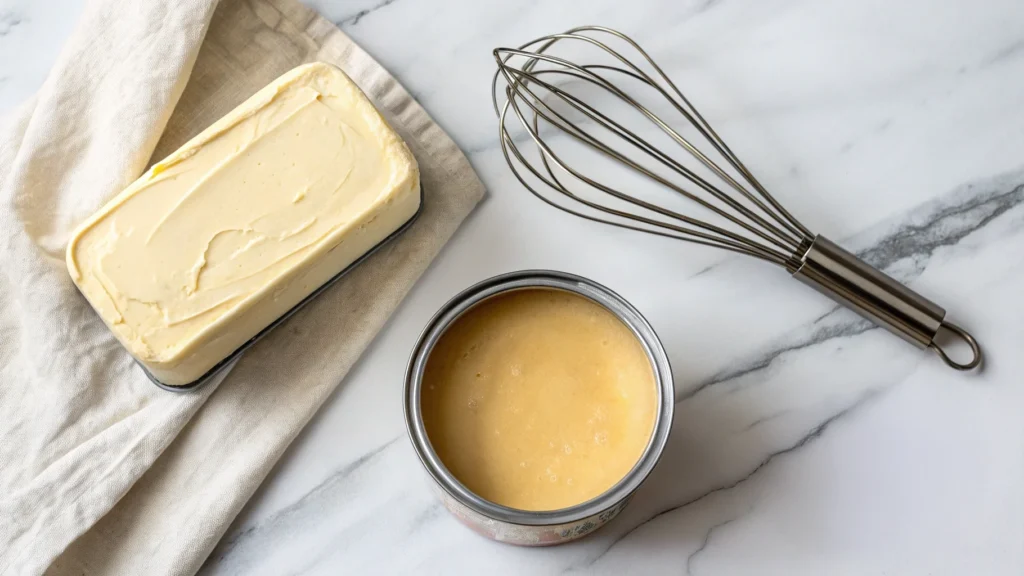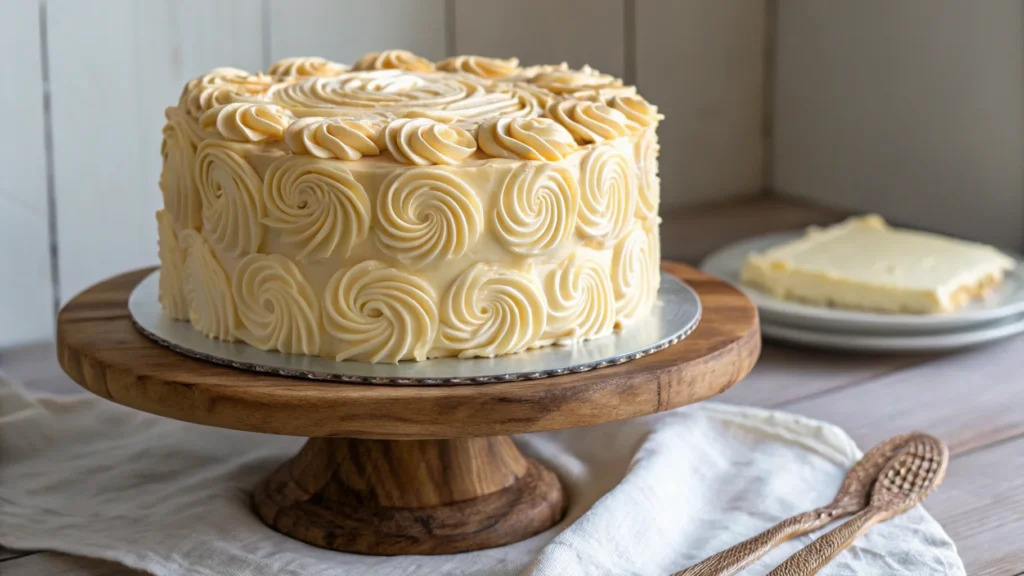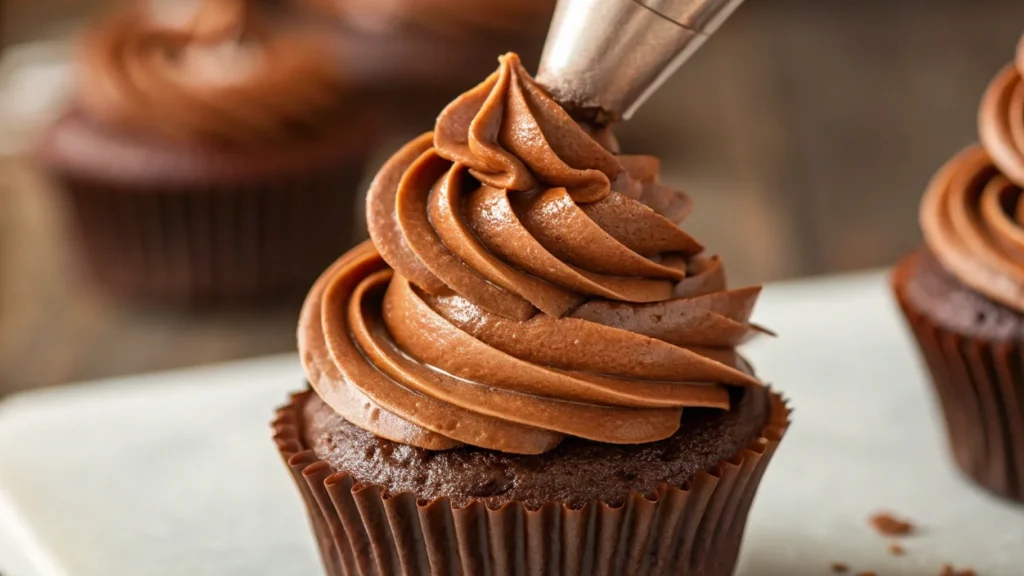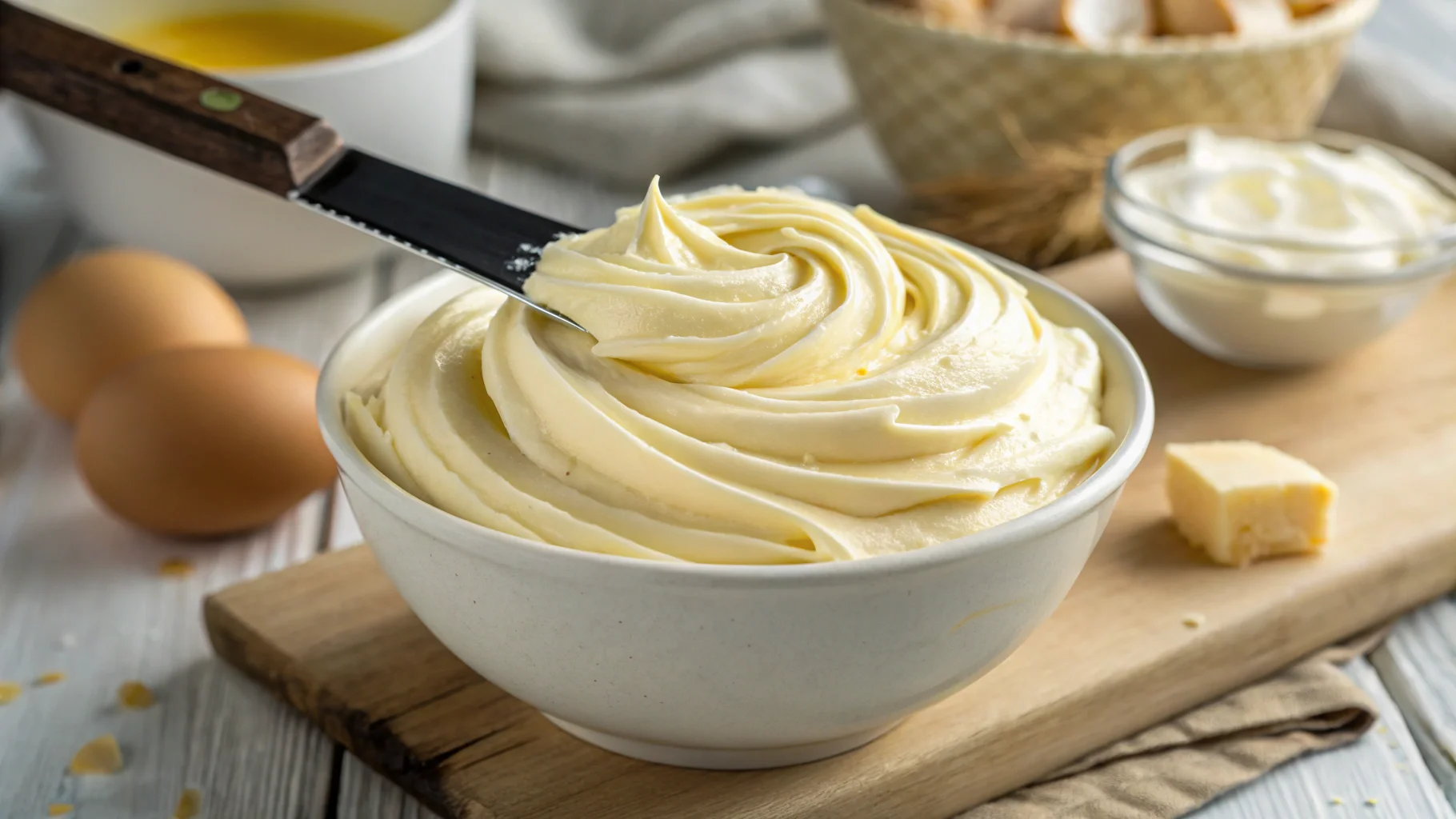Buttercream frosting is a staple in baking, but not all buttercreams are created equal. Russian Buttercream is a hidden gem in the world of cake decorating, loved for its silky texture, rich buttery flavor, and just-right sweetness. Unlike traditional buttercreams, it relies on sweetened condensed milk instead of powdered sugar, giving it a unique taste and texture.
In this article, we’ll explore how Russian Buttercream tastes, how it compares to other frostings, and the best ways to use and enhance it. Whether you’re a home baker or a pastry chef, this guide will help you master the art of Russian Buttercream.
Table of contents
Introduction to Russian Buttercream
What is Russian Buttercream?
Russian Buttercream, often called sweetened condensed milk buttercream, is a two-ingredient frosting made with butter and sweetened condensed milk. Unlike American Buttercream, which is sugar-heavy, this frosting is less sweet, incredibly creamy, and easy to whip up. Its simple preparation makes it a favorite among bakers who want a smooth, airy, and flavorful frosting without the grainy texture of powdered sugar.
Brief History and Origin
Russian Buttercream has its roots in Eastern European baking, where sweetened condensed milk is widely used in desserts. Many traditional Russian and Ukrainian cakes, such as Kiev Cake and Medovik (Honey Cake), use this luscious frosting. The condensed milk not only adds sweetness but also enhances the rich, caramel-like undertones that make this buttercream unique.
Why is Russian Buttercream Popular?
Why do bakers love Russian Buttercream? Here are a few reasons:
- Less sweet, more buttery – Perfect for those who dislike overly sugary frostings.
- Smooth and creamy texture – Spreads like a dream on cakes and cupcakes.
- Easy to make – Only two main ingredients, no complicated techniques.
- Pairs well with many flavors – Works great with vanilla, chocolate, coffee, and fruit.
Russian Buttercream’s light, silky texture and rich taste make it a fantastic alternative to traditional frostings. In the next section, we’ll break down the key ingredients that define its taste. Stay tuned!

Ingredients That Define the Taste
The unique taste of Russian Buttercream comes down to its simple yet powerful ingredients. Unlike other buttercreams that rely on powdered sugar or egg whites, this frosting keeps things minimal with just butter and sweetened condensed milk. But how do these ingredients shape the flavor and texture? Let’s break it down.
Sweetened Condensed Milk: The Key Flavor Enhancer
One of the standout ingredients in Russian Buttercream is sweetened condensed milk, which gives the frosting its smooth, velvety texture and natural sweetness. Unlike American Buttercream, which often tastes overwhelmingly sugary, condensed milk adds a mild, caramel-like sweetness with a touch of richness.
This ingredient also helps create a glossy, silky finish, making Russian Buttercream look just as good as it tastes. Plus, because it contains milk solids, it contributes a subtle creaminess that blends beautifully with butter.
Butter: The Base of the Creamy Texture
Butter is the foundation of Russian Buttercream, providing its luxurious mouthfeel and rich taste. Since this frosting contains no powdered sugar, the butter’s natural creaminess takes center stage.
For the best results, always use high-quality unsalted butter. Lower-quality butter can have a greasy aftertaste, which might overpower the delicate sweetness of condensed milk. Softening the butter properly before whipping is also crucial—it helps create an airy, fluffy texture that makes this buttercream so enjoyable.
Optional Additions: Vanilla, Cocoa, and More
While Russian Buttercream is delicious on its own, you can enhance its taste with a few extra ingredients:
- Vanilla extract – Adds warmth and depth to the flavor.
- Cocoa powder – Turns it into a silky chocolate Russian Buttercream.
- Coffee or espresso powder – Intensifies the sweetness with a hint of bitterness.
- Fruit purees or zest – Adds a refreshing, tangy contrast to the creamy texture.
With these additions, you can customize Russian Buttercream to complement any cake, cupcake, or dessert. But how does Russian Buttercream taste when compared to other buttercreams? Let’s find out in the next section.
How Does Russian Buttercream Taste Compared to Other Buttercreams?
Many bakers wonder: How does Russian Buttercream taste when stacked up against other popular frostings? Since each buttercream has a distinct flavor, texture, and sweetness level, let’s compare Russian Buttercream to the most common types.
Russian Buttercream vs. American Buttercream
American Buttercream is perhaps the most well-known frosting, but it’s also the sweetest and stiffest. Made with butter, powdered sugar, and milk or cream, it has a dense texture and a sugary taste that some find overpowering.
By contrast, Russian Buttercream is:
- Less sweet – Sweetened condensed milk adds a mild sweetness without the grit of powdered sugar.
- Smoother and lighter – Whipped butter gives it a fluffy, mousse-like consistency.
- Easier to spread – It glides effortlessly over cakes, making decorating a breeze.
If you love butter-based frostings but dislike the intense sweetness of American Buttercream, Russian Buttercream is a perfect alternative.
Russian Buttercream vs. Swiss Meringue Buttercream
Swiss Meringue Buttercream (SMBC) is known for its light, silky texture and balanced sweetness. It’s made by whipping egg whites and sugar over heat before adding butter, creating a marshmallowy fluffiness.
While both frostings are less sweet and smooth, there are some key differences:
- Russian Buttercream is richer – It has a stronger buttery flavor, whereas SMBC is more delicate.
- SMBC is more stable – Thanks to the egg whites, it holds its shape better in warm weather.
- Russian Buttercream is easier to make – No need for a double boiler or precise temperature control.
If you’re looking for a simple, creamy frosting with a strong butter flavor, Russian Buttercream is a great choice. But if stability and an ultra-light texture matter more, Swiss Meringue might be the winner.
Russian Buttercream vs. Italian Buttercream
Italian Meringue Buttercream (IMBC) is similar to SMBC but even more stable and structured. It’s made by whipping egg whites while slowly adding hot sugar syrup, then incorporating butter.
Compared to Russian Buttercream, IMBC:
- Has a firmer structure – Great for intricate cake designs and piping.
- Is slightly less rich – The meringue base makes it airier.
- Requires more technique – The sugar syrup step makes it trickier for beginners.
For those who want a buttery, easy-to-make frosting, Russian Buttercream is the clear winner. But if you need a buttercream that holds up under pressure, Italian Buttercream might be a better fit.
Final Thoughts on Russian Buttercream’s Taste
So, how does Russian Buttercream taste compared to other frostings? It’s rich, buttery, and subtly sweet—a perfect balance between indulgence and smoothness. Unlike American Buttercream, it’s not overwhelmingly sweet, and unlike meringue-based buttercreams, it’s incredibly simple to prepare.
If you’re looking for a creamy, velvety frosting that enhances your cakes without overpowering them, Russian Buttercream is an excellent choice. Up next, we’ll explore its texture and consistency, and how temperature can affect its performance. Stay tuned!

Texture and Consistency of Russian Buttercream
The texture and consistency of a frosting can make or break a cake. So, how does Russian Buttercream taste when it comes to mouthfeel? It’s light, silky, and spreads effortlessly, making it a dream for cake decorators. Let’s take a closer look at what gives it that signature smoothness.
Smooth and Creamy Texture Explained
Unlike American Buttercream, which can feel dense or grainy due to powdered sugar, Russian Buttercream is incredibly smooth. Because it relies on whipped butter and sweetened condensed milk, it has a naturally creamy consistency.
When made correctly, this buttercream:
- Feels light and airy, almost like a mousse.
- Spreads effortlessly on cakes and cupcakes.
- Has a melt-in-your-mouth texture with no sugar granules.
However, whipping technique matters! Over-whipping can cause air pockets, making the buttercream too soft or unstable.
How Temperature Affects Consistency
Since Russian Buttercream is mostly butter, temperature plays a huge role in its consistency. Here’s what you need to know:
- At room temperature (68-72°F/20-22°C): It’s soft and spreadable, perfect for frosting cakes.
- In the fridge: It firms up considerably, almost like butter. Before using, let it sit at room temperature for 15-30 minutes and re-whip if needed.
- In warm weather (above 75°F/24°C): It can become too soft or even melt, making it harder to pipe or hold its shape.
To stabilize it in warmer climates, some bakers add a small amount of cornstarch or extra butter. Alternatively, chilling the cake before serving helps maintain structure.
Now that we’ve covered the texture, let’s explore the best uses for Russian Buttercream in Part 5.
Best Uses for Russian Buttercream
Russian Buttercream isn’t just delicious—it’s also versatile. Whether you’re frosting a cake, filling pastries, or decorating cupcakes, this buttercream does it all.
Ideal Cakes and Cupcakes for Russian Buttercream
Because Russian Buttercream is lighter and less sweet, it pairs well with cakes that have a delicate crumb or rich flavors. Here are some great options:
- Sponge cakes – Its airy texture complements soft, fluffy layers.
- Chocolate cakes – The buttery richness balances deep cocoa flavors.
- Honey cakes (like Medovik) – Its mild sweetness enhances honey-infused layers.
- Vanilla cupcakes – Provides a smooth, silky contrast to classic vanilla flavors.
Russian Buttercream is ideal for cakes that don’t need heavy stability, making it perfect for simple layer cakes and cupcakes.
Can You Use Russian Buttercream for Piping?
Yes, but with some limitations. Russian Buttercream is softer than American or Swiss Meringue Buttercream, meaning it won’t hold intricate designs as well.
It works best for:
✅ Basic piping, like rosettes, swirls, and borders.
✅ Smooth cake finishes with a buttercream scraper.
❌ Intricate flowers or stiff decorations, as they may lose shape.
For more defined piping, you can refrigerate the buttercream for 10-15 minutes before using it.
How Well Does It Hold in Warm Weather?
If you’re baking in a hot climate, Russian Buttercream might not be the best choice. Since it’s mostly butter, it can soften quickly in heat.
To make it more stable:
- Chill your cake before serving – This prevents the frosting from sliding.
- Use a firmer butter-to-condensed-milk ratio – Slightly increasing the butter makes it more stable.
- Store in a cool place – Keep cakes in the fridge until just before serving.
Despite these challenges, Russian Buttercream remains a top choice for its flavor, ease of use, and luxurious texture.
Final Thoughts on Its Best Uses
So, how does Russian Buttercream taste when paired with different desserts? Its rich, buttery flavor and velvety texture make it an excellent choice for soft cakes, cupcakes, and simple decorations. While it’s not ideal for extremely hot conditions or intricate piping, its melt-in-your-mouth quality makes it worth trying.
In the next section, we’ll explore how to enhance its flavor with chocolate, coffee, and other delicious add-ins. Stay tuned!Enhancing the Flavor of Russian Buttercream
Russian Buttercream is already rich, creamy, and smooth, but did you know you can easily customize its flavor? Whether you want a chocolatey twist, a coffee boost, or a fruity burst, this buttercream is incredibly versatile. But first, how does Russian Buttercream taste when flavored? The base remains buttery and mildly sweet, but with the right add-ins, it transforms into something truly special.
Adding Cocoa for a Chocolate Version
Turning Russian Buttercream into Chocolate Russian Buttercream is simple and delicious. Since this frosting is naturally smooth and light, adding cocoa powder creates a rich, velvety chocolate flavor without making it too dense.
To make Chocolate Russian Buttercream:
- Whip the butter first – This keeps the frosting light and fluffy.
- Add 2-3 tablespoons of sifted cocoa powder – Use unsweetened cocoa for a deep, chocolatey taste.
- Mix until fully combined – If the buttercream thickens too much, add a tablespoon of warm milk to smooth it out.
For an even bolder chocolate flavor, try melting dark chocolate and mixing it in gradually. The result? A silky, rich chocolate buttercream that’s perfect for cakes and cupcakes!
Using Coffee to Intensify the Taste
If you love the combination of butter and coffee, this variation is a must-try. Adding coffee to Russian Buttercream enhances its depth and richness, making it a great choice for chocolate or mocha cakes.
To make a coffee-infused version:
- Dissolve 1 teaspoon of instant coffee in 1 tablespoon of warm water.
- Add it gradually while whipping the buttercream.
- For a stronger taste, increase the amount or use espresso powder.
This subtle yet deep coffee flavor pairs beautifully with vanilla, chocolate, or caramel cakes.
Fruit Purees and Extracts for Variations
Want a fruity twist? Russian Buttercream pairs wonderfully with berries, citrus, and tropical flavors. Since it’s already buttery and slightly sweet, fruit-based add-ins create a refreshing contrast.
Here are some tasty options:
- Berry Purees: Add strawberry, raspberry, or blueberry puree for a natural fruit flavor.
- Citrus Zest or Juice: Lemon, orange, or lime zest brightens up the buttercream.
- Coconut Extract: A dash of coconut extract brings a tropical flair.
To prevent the buttercream from getting too thin, only add a small amount of liquid at a time. If it becomes too runny, refrigerate it for a few minutes before using.
With these flavor enhancements, Russian Buttercream can be transformed into a variety of delicious frostings. But what if you still have questions about its taste and texture? Let’s dive into some frequently asked questions in the next section.
FAQs About Russian Buttercream
Many bakers wonder, how does Russian Buttercream taste compared to other frostings? Or how long can it sit out? Below, we answer some of the most common questions to help you master this creamy delight.
How sweet is Russian Buttercream compared to others?
Unlike American Buttercream, which is often overpoweringly sweet, Russian Buttercream is mild and balanced. The sweetened condensed milk provides just enough sweetness without making it cloying. If you prefer less sugary frostings, this is a perfect choice.
Does Russian Buttercream harden in the fridge?
Yes! Since it’s butter-based, it firms up when chilled. If your frosting becomes too stiff after refrigeration, let it sit at room temperature for 15-30 minutes before using. A quick re-whip will bring back its creamy texture.
Can Russian Buttercream be made ahead of time?
Absolutely! You can make it 1-2 days in advance and store it in an airtight container in the fridge. Before using, let it come to room temperature and re-whip for the best consistency.
Can you freeze a cake with Russian Buttercream?
Yes! Russian Buttercream freezes well, making it great for advance cake prep. Just follow these steps:
- Frost the cake and let it set.
- Wrap it tightly in plastic wrap.
- Store it in the freezer for up to 2 months.
When ready to serve, thaw the cake in the fridge overnight, then let it come to room temperature before slicing.

Conclusion and Final Thoughts
Why You Should Try Russian Buttercream
If you’ve been wondering, how does Russian Buttercream taste, the answer is simple: it’s rich, buttery, and perfectly sweet without being overwhelming. This frosting is an excellent alternative to traditional buttercreams because it’s:
- Less sweet than American Buttercream
- Smoother and silkier than Swiss Meringue Buttercream
- Easier to make than Italian Buttercream
With only two main ingredients—butter and sweetened condensed milk—it’s foolproof, quick to prepare, and endlessly customizable. Whether you’re frosting a simple vanilla cake or experimenting with chocolate and coffee variations, this buttercream delivers on taste and texture.
Final Tips for Perfecting the Taste
Before you get started, keep these final tips in mind to achieve the best possible Russian Buttercream:
✅ Use high-quality butter – This makes all the difference in flavor and texture.
✅ Whip the butter well – It should be light and fluffy before adding condensed milk.
✅ Avoid over-mixing – Over-whipping can cause separation or air pockets.
✅ Watch the temperature – Keep butter at room temperature for smooth mixing.
✅ Experiment with flavors – Try cocoa, coffee, or fruit purees for unique variations.
Russian Buttercream is one of the easiest, most delicious frostings you’ll ever make. Whether you’re a beginner or an experienced baker, this frosting is guaranteed to impress.
Final Call to Action
Now that you know how does Russian Buttercream taste and how to make it, why not try it for yourself? Experiment with different flavors, pair it with your favorite cakes, and let us know how it turns out!
For more baking inspiration, explore other delicious dessert recipes on your favorite food blogs. Happy baking!

